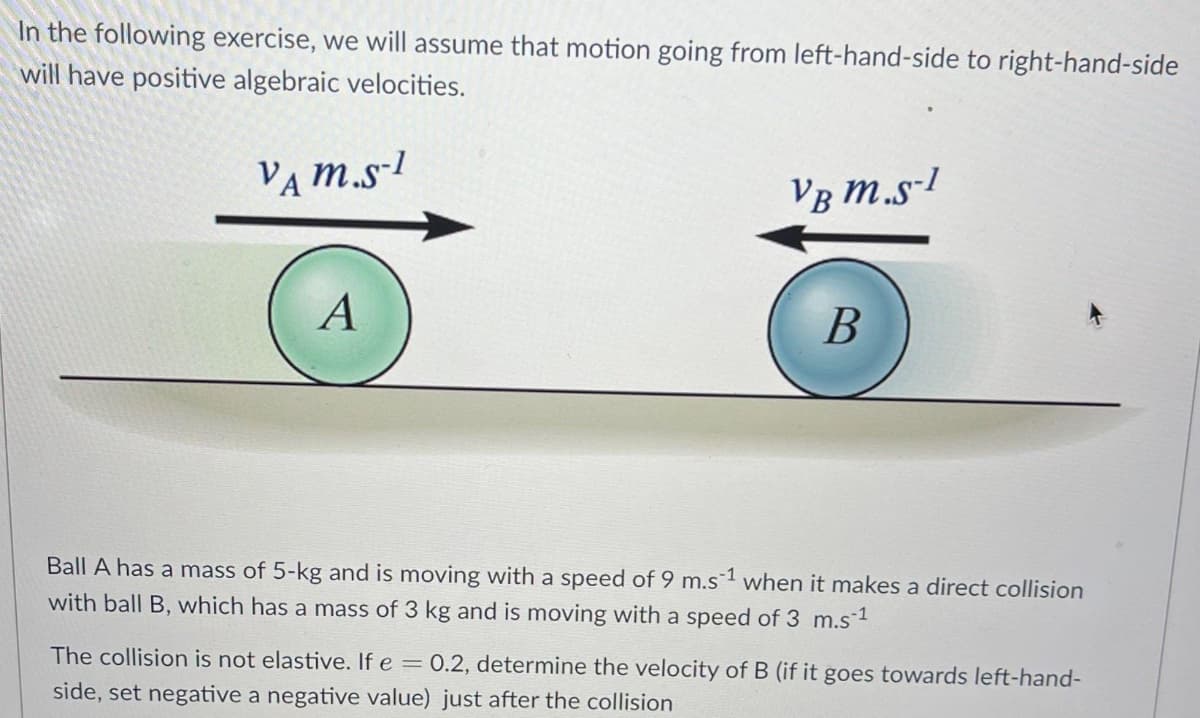In the following exercise, we will assume that motion going from left-hand-side to right-hand-side will have positive algebraic velocities. VAM.S-1 VB M.S-1 B A Ball A has a mass of 5-kg and is moving with a speed of 9 m.s1 when it makes a direct collision with ball B, which has a mass of 3 kg and is moving with a speed of 3 m.s-1 The collision is not elastive. If e = 0.2, determine the velocity of B (if it goes towards left-hand- side, set negative a negative value) just after the collision
In the following exercise, we will assume that motion going from left-hand-side to right-hand-side will have positive algebraic velocities. VAM.S-1 VB M.S-1 B A Ball A has a mass of 5-kg and is moving with a speed of 9 m.s1 when it makes a direct collision with ball B, which has a mass of 3 kg and is moving with a speed of 3 m.s-1 The collision is not elastive. If e = 0.2, determine the velocity of B (if it goes towards left-hand- side, set negative a negative value) just after the collision
Principles of Physics: A Calculus-Based Text
5th Edition
ISBN:9781133104261
Author:Raymond A. Serway, John W. Jewett
Publisher:Raymond A. Serway, John W. Jewett
Chapter17: Energy In Thermal Processes: The First Law Of Thermodynamics
Section17.5: The First Law Of Thermodynamics
Problem 17.4QQ
Related questions
Question
ASAP

Transcribed Image Text:In the following exercise, we will assume that motion going from left-hand-side to right-hand-side
will have positive algebraic velocities.
VAM.S-1
VB M.S-1
B
A
Ball A has a mass of 5-kg and is moving with a speed of 9 m.s1 when it makes a direct collision
with ball B, which has a mass of 3 kg and is moving with a speed of 3 m.s ¹
The collision is not elastive. If e = 0.2, determine the velocity of B (if it goes towards left-hand-
side, set negative a negative value) just after the collision
Expert Solution
This question has been solved!
Explore an expertly crafted, step-by-step solution for a thorough understanding of key concepts.
Step by step
Solved in 3 steps with 3 images

Knowledge Booster
Learn more about
Need a deep-dive on the concept behind this application? Look no further. Learn more about this topic, physics and related others by exploring similar questions and additional content below.Recommended textbooks for you

Principles of Physics: A Calculus-Based Text
Physics
ISBN:
9781133104261
Author:
Raymond A. Serway, John W. Jewett
Publisher:
Cengage Learning

Classical Dynamics of Particles and Systems
Physics
ISBN:
9780534408961
Author:
Stephen T. Thornton, Jerry B. Marion
Publisher:
Cengage Learning

Principles of Physics: A Calculus-Based Text
Physics
ISBN:
9781133104261
Author:
Raymond A. Serway, John W. Jewett
Publisher:
Cengage Learning

Classical Dynamics of Particles and Systems
Physics
ISBN:
9780534408961
Author:
Stephen T. Thornton, Jerry B. Marion
Publisher:
Cengage Learning